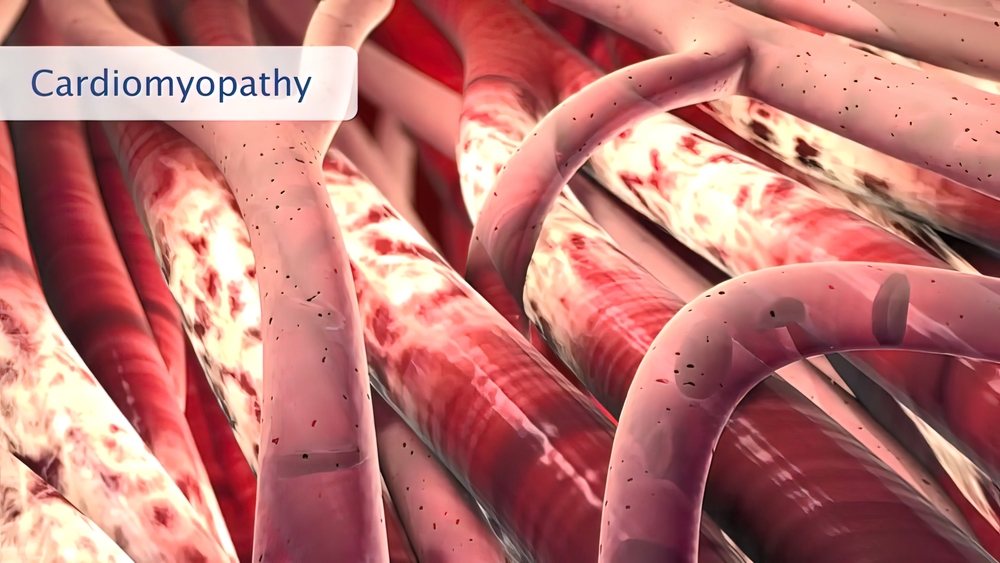
Overview
Cardiomyopathy is a disease of the myocardium or heart muscle. In cardiomyopathy, the heart becomes too weak to pump blood to the other parts of the body. In some cases, it can lead to heart failure.
The major types of cardiomyopathy include dilated hypertrophic and restrictive cardiomyopathy.
Treatment might range from medications, surgically implanted devices, and heart surgery. Depending on the type of cardiomyopathy and its severity, you might need a heart transplant.
Key facts
- Cardiomyopathy makes it difficult for the heart to pump blood efficiently
- Some symptoms include fatigue, heart palpitations, or shortness of breath.
- Cardiomyopathy progresses and worsens over time.
- Treatment can slow down how rapidly it progresses to improve your quality of life.
Symptoms
At the beginning stage, cardiomyopathy does not show any symptoms. However, as it progresses, you might begin to experience some of its signs and symptoms, which include;
- Shortness of breath even when at rest
- Bloating of the abdomen due to fluid buildup
- Swelling (edema) of the legs, ankles, and feet
- Cough
- Fatigue
- Heart palpitations
- Chest pressure or discomfort
- Dizziness and fainting
These symptoms worsen very quickly for some people, while for others, it takes longer to reach critical stages. However, cardiomyopathy symptoms will ultimately deteriorate if left untreated.
Diagnosis
Your healthcare giver might refer you to a cardiologist if you have problems with your chest or heart. The cardiologist will perform a physical examination and request one or more of these diagnostic tests;
- Ambulatory monitoring: Devices will be used to track your heart movements and rhythm.
- Chest X-ray: A chest X-ray may be conducted to take pictures inside your chest.
- CT scan: Takes images of your blood vessels and heart.
- Echocardiogram (echo): Takes pictures of your heart’s valves and chambers and measures how well your heart is pumping.
- Electrocardiogram (EKG): This simple and pain-free test records your heart’s electrical activity or signals.
- Cardiac catheterisation: This procedure uses a catheter (a thin tube inserted through a blood vessel) to measure the heart pressure.
- Myocardial biopsy: A small tissue of your heart will be removed to check for changes in its cells.
Causes
The cause of cardiomyopathy is often unknown. It can be caused by viral infections that affect the heart in some cases.
Causes are generally grouped into two, inherited and acquired.
Inherited means you were born with cardiomyopathy genes inherited from your parents or relatives
Acquired means you developed the condition due to other illnesses, infections, or diseases during your life. These diseases might include;
- Damage to the heart tissue due to a heart attack
- Coronary artery disease
- Infections in the heart muscle
Prevention
There’s no way to prevent acquired cardiomyopathy, which is the type you inherit at birth. However, you can take steps to reduce your risk of developing conditions that can lead to cardiomyopathy. They include;
- Keep your cholesterol within healthy ranges.
- Control your blood pressure.
- Manage underlying conditions such as diabetes, hypertension, or sleep apnea.
- Schedule regular checkups with a healthcare giver
Treatment
Treatment for cardiomyopathy majorly focuses on slowing down the progression of the disease. You’ll need to go in for regular health checkups to monitor your heart’s condition.
Your healthcare provider might recommend one of these;
- Medications: Some medications can manage cardiomyopathy by improving blood flow and treating underlying conditions. These medications include warfarin (Coumadin®), beta-blockers, or medicines that lower cholesterol levels.
- Devices to correct arrhythmias: Devices such as Pacemakers or implantable cardioverter defibrillators (ICDs) can correct irregular heart rhythms. They monitor the heartbeat and send electrical signals to your heart when an arrhythmia starts.
- Devices to improve blood flow: Devices like cardiac resynchronization therapy (CRT) help control the contractions between the left and right sides of the heart. Additionally, a left ventricular assist device (LVAD) helps your heart pump blood effectively.
- Surgery: If your symptoms are severe or critical underlying heart conditions, your healthcare giver might suggest an open-heart surgery or heart transplant. This is usually the last resort when other treatment options fail.
Conclusion
Cardiomyopathy is a disease that affects the heart, causing it not to pump blood effectively. The disease is either inherited at birth or acquired due to other heart conditions. Treatment for cardiomyopathy may include lifestyle modifications, medications, extreme cases, and surgery. With proper healthcare, you can still live a good quality of life with cardiomyopathy.
MOST COMMON
